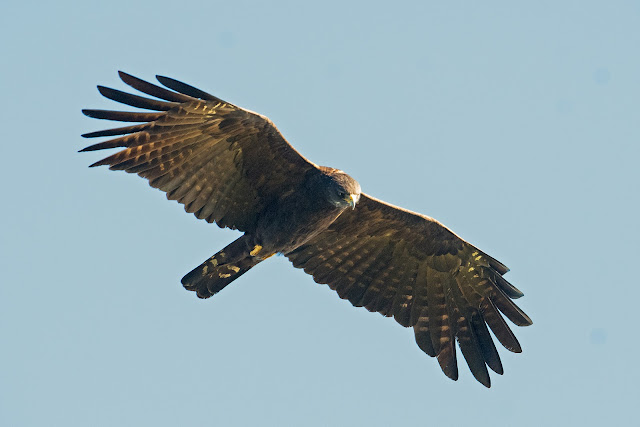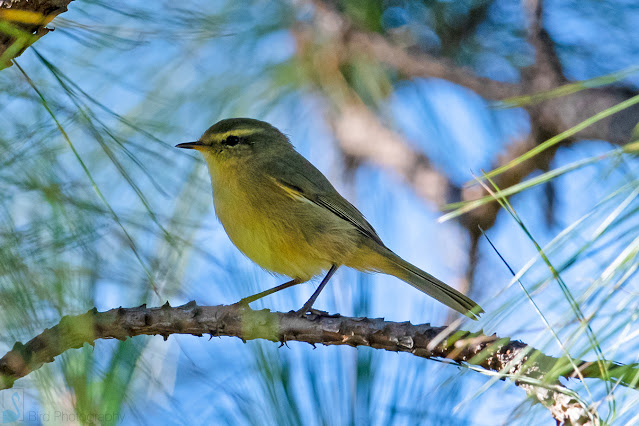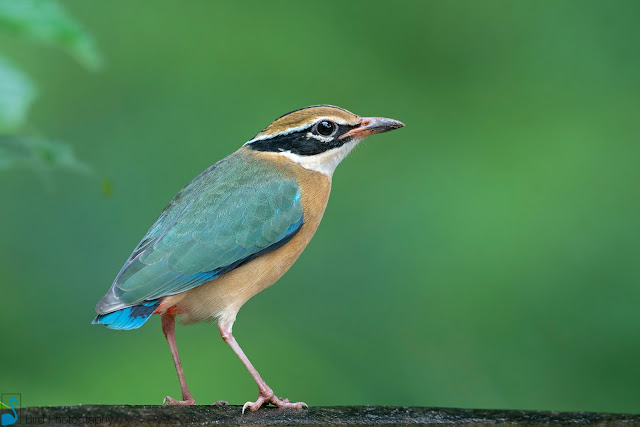Over the last decade our journey into the various forests looking for different species of birds has been exhilarating. Our bird count had touched 987 (in India) after our recent trip and typically had the desire to reach the 1000 mark by the end of 2023. Each time, when we set out to find different species, the words of my Spiritual Master echo in my mind. “We are born for desires...fulfill them...the day you are without desires...Its Moksha (Sanskrit: मोक्ष Mokṣa; liberation) - Paramji Alias His Holiness.
With another destination and some birds on our mind, we left early in the morning by road from Dosdewa Forest, towards Aizawl, Mizoram. Mizoram as a state not only shares its land borders with Tripura, Assam, Manipur, Bangladesh and the Chin State of Burma, but also is one of the Seven Sister States in North Eastern part of India.
In about an hour, we reached the Kanhmun Border Checkpost in Mizoram, by 0630hrs. We stopped here to obtain the Inner Line Permit. We were the only ones at this hour to request for the permits, the officer was very helpful and promptly issued the permits. The houses around the post were typically very different when compared to the ones in Assam, especially around the border. Soon we set out on the road, that had started to twine and the elevation increased with each turn. The hills around are steep (avg. height 1000 meters) and separated by rivers which flow either to the north or south creating deep gorges between the hill ranges. Between the gorges, the clouds could be seen floating endlessly. A breathing taking view kept moving along with us and it seemed the air whispered, take a break, make some memories.
 |
| Clouds floating endlessly - Mizoram |
The road had two lanes only, but as there was no traffic, we were covering the distance as expected. Along the highway, at regular intervals we would see some local shops selling fruits and vegetables, that was managed by the local tribal folks. We stopped at one such location. To our surprise, none of them spoke English here and obviously we did not speak their language, we could only ask for fruits using the sign language. The place was somewhere near Zawlnuam, Mamit. Digi ji glanced and up and saw a very large flock of Amur Falcon, they were in hundreds, flying quite high but all of them in one direction, later they started to circle over a hill. Our equipment was all packed and tucked away as we were not expecting any major birding en route, obviously we were taken by surprise. As the flock was large, we had enough time to set up the equipment and take some record images.
 |
| Amur Falcon - Flock (Image by Aseem Kothiala) |
 |
| Amur Falcon - (Image by Aseem Kothiala) |
After being on the road for almost eight hours, we entered Aizawl town, just around lunch hours. The traffic was so civilised here. This is where we met our host cum naturalist for the region, Mr. Joe Thanga. His hospitality began from this very moment, first he drove us to a fine restaurant and later towards Sialsuk, which was another two and half hour drive from Aijwal. Prior to our destination, we transited along the village of Muallungthuthe, which is famous as the Tropic of Cancer passes through its zone.
 |
| Tropic of Cancer |
We reached the sunset point, just a few minutes prior to sundown. We witnessed a serene view from the hillock. Far at the horizon as the sun was setting off the day, the entire mountain range turned into shades of orange and red. Finally as the sun set, we headed towards the Sialsuk village.
On
the dinner table we started to discuss and plan our itinerary, which
had to be altered in a big way. Primary, we were to stay here in Sialsuk
for two days and then drive into The Blue Mountain (Phawngpui) National Park,
which is located in southeastern part of the state. Due to the rains
this season the uphill road had turned into a downhill stream, after
drying it had become very uneven and not worthy of even a bumpy drive.
We were given to understand that instead of an hour’s drive, we will
have to trek 5-6 hours to reach the park. Due to which we will need more
time to reach and get down to the base. Joe also ensured that most
target birds can be seen even at the Phawngpui National Park, commonly
called as Far Pak by the locals.
The next day morning, we went around birding in the hills of Sialsuk.
The Red-whiskered Bulbul were seen in large number, as we entered the
trail, could hear the Spot-breasted Laughingthrush, who typically, would
appear very briefly and disappear. From the thick canopy, we sighted a
Black Eagle, who flew very close to us and finally, sat on a branch very
high from where we were. A large mixed hunting party appeared and the
forest was filled with their chirps, we could identify a few as the
Grey-hooded Warbler, along with some other warblers that we could not
identify due to low light. However we sighted a couple of Scarlet
Minivet. White-throated Bulbul, and a few other birds were seen too. (Refer to eBird Check list).
As we waited for the hunting party to come closer, sighted a small
flock of Lesser Necklaced Laughingthrush going down hill, they managed
to stay low and disappear into the thickets.
A couple of hours
later, we decided to walk back towards the Mizo village. As we
interacted with the residents here, discovered that most of them spoke
English, unlike the tribals we had met when we entered the state. The
area was covered with wild bamboo forests, many of which are largely
unexploited. As we gazed into the open skies, sighted a small flock of
Striated Swallow. We returned back to the camp, only to pack again and
head out towards Sangau, which was a much larger village, situated in
the Lawngtlai district.
Sangau, is close to India–Myanmar
border and was chosen as our base camp by Joe Thanga. We had to drive
almost nine hours plus to reach this place. Inspite the distance being a
little less than 175 kilometers from Sialsuk, took us this long, due
the major repairs that was being carried out. There were times when we
could just see the brown dust that was rising due to movement of trucks
carrying construction material, making us feel we were driving into an
open desert. We crossed the Kolodyne river that flows along the eastern
side of the Park and also forms the international border with Myanmar.
We stopped briefly along the road near Darzo to enjoy the sunset and
finally reached our destination for the day by half past six in the
evening.
 |
| Sunset near Darzo - Mizoram |
The next morning, we packed just our very basic personal items, equipment and the supplies that would be needing over the next four nights and five days. Most important for us was to carry enough batteries for our equipment, as there would be no electricity at the Forest Rest House, Far Pak. We as decided were to trek towards the highest peak in Mizoram called the Phawngpui Peak (2,157 m), in the Blue Mountain.
The trek began from the village at the base. The path was surely not worthy of drive, even by a four wheel drive (4x4) vehicle. As we kept climbing could see a large flock of Striated Swallow, perched on a wire, that was over the bed of clouds.
 |
| On the way towards Far Pak - Mizoram |
 |
| Slaty-backed Flycatcher - Image by Aseem Kothiala |
We
reached and waited at the starting point of the Phawngpui National
Park, where Joe had arranged for a packed meals for us. We soon began
the trek again and as we were reaching saw some amazing cliffs and
patches of natural grasslands on the tableland also called as Far Pak.
 |
| Tableland, Far Pak, Mizoram |
 |
| Forest Rest House, Far Pak, Mizoram |
The weather was great, so we quickly assembled our equipment and started to explore the area. We could see a semi-circular series of cliffs on the western side called Thlazuang Kham, which has a sharp edge and a deep gorge. We sighted a Black Eagle that was flying around from one cliff to another.
 |
| Black Eagle - Image by Aseem Kothiala |
Joe, suggested we relax after today's long trek and instead watch the
sunset from this point. It was one of the finest we had ever seen. The
saturation and hues in the sky were unmatched. The breeze was cool and
the entire ambience was mesmerising.
 |
| Sunset at Phawngpui National Park - Mizoram |
Our targets here was to see the endemic Chin Hills Wren-babbler, and a bird that had remained elusive for about 25 years, but was now being sighted since a couple of years, the Mount Victoria Babax.
There are two options one has here, rather three options. One is to
look for the birds on the tableland adjacent to the Forest Rest House,
second take the forest trail that leads to the peak and third obviously
the trail that leads one back to the base camp.
This morning we
decided to take the trail that leads us back to the base camp, we could
hear and see the Chin Hills Wren-babbler, three to four times, but
wasn’t providing us the opportunity to make an image. From the edge
where we stood, saw a large flock of House Swift and Asian House-martin
fly around in an acrobatic flight pattern.
Near the Forest Rest House, we sighted the Hume’s Treecreeper who would fly on to the bottom of the tree and quickly move up in a pattern that is not very predictable.
 |
| Hume's Treecreeper - Image by Aseem Kothiala |
By late morning we also sighted the Rufous-crowned Prinia another lifer for us. Grey Bushchat and the Little bunting was seen on good numbers here apart from Warblers, off which the Brown Bush Warbler was a lifer for us. We did sight the Assam Laughingthrush who were not as bold as the Striped Laughingthrush.
 |
| Rufous-crowned Prinia - Image by Aseem Kothiala |
 |
| Buff-throated Warbler - Image by Aseem Kothiala |
 |
| Flavescent Bulbul - Image by Aseem Kothiala |
Moments later, we were asked to reach the other cliff, as they could hear the loud calls of the Mount Victoria Babax. The bird could be seen only at a particular angle along the edge. The bird had placed itself between two branches and well camouflaged. Took me a while to find the bird through my lens. Though it was at a distance, we were happy to get this lifer.
Being
a full moon day, even after the sunset, the natural ambient light
enchanced the beauty of the forest, the cool wind, soft moon light and
no network, one of the best combination we had been longing for a while.
 |
| Full Moon - Mizoram |
Today we took the trail towards the peak, walking through forests and negotiating the tunnels made of overgrown bamboo and high grass. By the end of the day we had sighted a few more lifers, the Crested Finchbill, Stripe-breasted Woodpecker to name a few (Refer to our eBird Checklist).
 |
| Crested Finchbill - Image by Aseem Kothiala |
 |
| Stripe-breasted Woodpecker - Image by Aseem Kothiala |
A
lone Himalayan Griffons was seen soaring in the cloudy sky. By now we
were getting accustomed to the tabletop and its surroundings. Marvelyn
and Digi ji had identified a nice spot, the previous evening to
photography the skulker - Chin Hill Wren-babbler. We came here in the
morning and could see three different individuals. After making a couple
of image, I decided to leave them and walk back towards the tabletop
again.
 |
| Chin Hill Wren-babbler - Image by Aseem Kothiala |
The day was even more special as we sighted three individuals of the Mount Victoria Babax, that gave us a nice sighting. We spent a lot of time watching them, as they moved from one tree to another. later like every other evening we returned to the cliff to watch the sun set.
 |
| Mount Victoria Babax - Image by Aseem Kothiala |
 |
| The last Sunset - Phawngpui Blue Mountain National Park (Mizoram) |
Being our last morning here at the camp here, we spent some time around the Forest Rest House and saw a lot of commoners which included the Whiskered Yuhia, Rufous-backed Sibia, Streak-breasted Scimitar-Babbler to name a few (Refer to our eBird Checklist). We then trekked back to the camp in Sangau to retire for the night, that took us around three to four hours.
Finally,
the next day morning, we headed back towards Aizwal, this time it took
us almost twelve hours to reach Lengpui, a town near the airport. This
time we came across many road side shops, the price tag was mentioned on
the packet, it was unmanned, on can simply pick the items and leave the
cash in money boxes, that were not even locked. An exemplary way to
exhibit honesty and culture.
It
would be unfair not to mention Cabin Hotel in Hnahthial, where we had
our meals onward and on the way back to Aizwal. The next morning we
squeezed in a couple of hours for birding, prior to boarding the flight
to Mumbai, India.
Bird watching in the Blue Mountains of Mizoram
was truly an enchanting experience for us. The lush greenery and diverse
ecosystem of the region provided a perfect habitat for a wide variety
of bird species. From colorful songbirds to majestic raptors, the Blue Mountains did offer a rich tapestry of avian life waiting to be discovered.
By the end of this trip, we had bagged 15 more lifers, taking the bird count in India above the 1000 mark!
Thanking my birding pals Seema Kothiala, Marveyln Diaz, Satish Thayapurath and Digvijay Singh Rathore. We missed our good friends Peter Lobo and Dr Ian D’souza, who were to be a part of this trip as well, but could not make it. Last but not the least we thank Mr. Joe Thanga, whose hospitality was top notch. Even in a place this far and remote, provided us with excellent facilities, clean rooms and good food. His team mates, Isak, Kiddy, Chhanuka were outstanding in their own very way.
 |
| Joe Thanga, Kiddy, Satish T, Isak, Marvelyn D, Digvijay R, Seema K, Chhanuka & Myself |
Happy Birding!
1 Asian Palm Swift Cypsiurus balasiensis
2 House Swift Apus nipalensis
CUCULIFORMES: Cuculidae
3 Green-billed Malkoha Phaenicophaeus tristis
ACCIPITRIFORMES: Accipitridae
4 Himalayan Griffon Gyps himalayensis
5 Black Eagle Ictinaetus malaiensis
PICIFORMES: Picidae
6 Stripe-breasted Woodpecker Dendrocopos atratus
7 Crimson-naped Woodpecker Dryobates cathpharius
PICIFORMES: Ramphastidae
8 Great Barbet Psilopogon virens
9 Blue-throated Barbet Psilopogon asiaticus
PSITTACIFORMES: Psittaculidae
10 Vernal Hanging Parrot Loriculus vernalis
PASSERIFORMES: Campephagidae
11 Scarlet Minivet Pericrocotus flammeus
PASSERIFORMES: Vireonidae
12 Himalayan Shrike-babbler Pteruthius ripleyi
13 White-browed Shrike-Babbler Pteruthius aeralatus
PASSERIFORMES: Dicruridae
14 Ashy Drongo Dicrurus leucophaeus
PASSERIFORMES: Monarchidae
15 Black-naped Monarch Hypothymis azurea
PASSERIFORMES: Dicaeidae
16 Plain Flowerpecker Dicaeum concolor
17 Scarlet-backed Flowerpecker Dicaeum cruentatum
PASSERIFORMES: Nectariniidae
18 Little Spiderhunter Arachnothera longirostra
19 Fire-tailed Sunbird Aethopyga ignicauda
20 Green-tailed Sunbird Aethopyga nipalensis
21 Mrs. Gould's Sunbird Aethopyga gouldiae
PASSERIFORMES: Irenidae
22 Orange-bellied Leafbird Chloropsis hardwickii
PASSERIFORMES: Motacillidae
23 Olive-backed Pipit Anthus hodgsoni
24 White Wagtail Motacilla alba
PASSERIFORMES: Emberizidae
25 Little Bunting Schoeniclus pusillus
PASSERIFORMES: Stenostiridae
26 Yellow-bellied Fairy-fantail Chelidorhynx hypoxanthus
27 Grey-headed Canary-flycatcher Culicicapa ceylonensis
PASSERIFORMES: Paridae
28 Green-backed Tit Parus monticolus
PASSERIFORMES: Cisticolidae
29 Rufous-crowned Prinia Prinia khasiana
PASSERIFORMES: Locustellidae
30 Brown Bush Warbler Locustella luteoventris
PASSERIFORMES: Hirundinidae
30 Asian House Martin Delichon dasypus
31 Striated Swallow Cecropis striolata
32 Wire-tailed Swallow Hirundo smithii
PASSERIFORMES: Pycnonotidae
33 White-throated Bulbul Alophoixus flaveolus
34 Ashy Bulbul Hemixos flavala
35 Mountain Bulbul Ixos mcclellandii
36 Black Bulbul Hypsipetes leucocephalus
37 Crested Finchbill Spizixos canifrons
38 Striated Bulbul Pycnonotus striatus
39 Black-crested Bulbul Pycnonotus melanicterus
40 Red-whiskered Bulbul Pycnonotus jocosus
41 Red-vented Bulbul Pycnonotus cafer
42 Flavescent Bulbul Pycnonotus flavescens
43 Large Niltava Niltava grandis
44 Small Niltava Niltava macgrigoriae
45 Oriental Magpie Robin Copsychus saularis
46 Rufous-bellied Niltava Niltava sundara
PASSERIFORMES: Phylloscopidae
47 Buff-barred Warbler Abrornis pulcher
48 Buff-throated Warbler Phylloscopus subaffinis
49 Grey-hooded Warbler Seicercus xanthoschistos
PASSERIFORMES: Aegithalidae
50 Black-throated Tit Aegithalos concinnus
PASSERIFORMES: Zosteropidae
51 Stripe-throated Yuhina Yuhina gularis
52 Whiskered Yuhina Yuhina flavicollis
PASSERIFORMES: Timaliidae
53 Chin Hills Wren Babbler Spelaeornis oatesi
54 Streak-breasted Scimitar Babbler Pomatorhinus ruficollis
PASSERIFORMES: Leiothrichidae
55 Spot-breasted Laughing-thrush Garrulax merulinus
56 Assam Laughingthrush Trochalopteron chrysopterum
57 Lesser Necklaced Laughing-thrush Garrulax monileger
58 Greater Necklaced Laughing-thrush Garrulax pectoralis
59 Mount Victoria Babax Pterorhinus woodi
60 Striped Laughing-thrush Trochalopteron virgatum
61 Grey Sibia Heterophasia gracilis
62 Rufous-backed Sibia Leioptila annectens
PASSERIFORMES: Certhiidae
63 Hume's Treecreeper Certhia manipurensis
PASSERIFORMES: Sittidae
64 White-tailed Nuthatch Sitta himalayensis
65 Velvet-fronted Nuthatch Sitta frontalis
PASSERIFORMES: Muscicapidae
66 Hill Blue Flycatcher Cyornis banyumas
67 Rufous-bellied Niltava Niltava sundara
68 Verditer Flycatcher Eumyias thalassinus
69 Slaty-backed Flycatcher Ficedula sordida
70 Blue Rock Thrush Monticola solitarius
71 Grey Bushchat Saxicola ferreus
72 Little Pied Flycatcher Ficedula westermanni
73 Chestnut-bellied Rock Thrush Monticola rufiventris
PASSERIFORMES: Turdidae
74 Scaly Thrush Zoothera dauma
75 Eyebrowed Thrush Turdus obscurus
























































